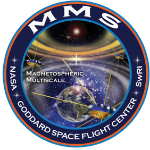We present a case study of electron acceleration due to the interaction between Earth's bow shock and a solar wind magnetic depression. The magnetic depression is identified as a reconnecting current sheet. It is observed both at the bow shock, using the Magnetospheric Multiscale (MMS) spacecraft, and upstream of the shock at the Lagrange point 1 (L1) using the ACE, WIND, and DSCOVR spacecraft.The L1 observations show little to no suprathermal electron flux enhancement compared to the background solar wind, suggesting that the acceleration is completely due to the interaction with the shock and not due to ongoing reconnection at the current sheet. The interaction of the current sheet enables electrons to be accelerated from thermal energies (10-20\,eV) up to suprathermal energies (1-5 keV) in an acceleration process producing a power-law with a spectral index, p, close to that predicted by 1st order Fermi acceleration (p = -2). The observations are compared to a numerical model of Fermi acceleration, and good agreement is shown. This provides a mechanism for electron acceleration from thermal to suprathermal energies. Thus, adding another piece to resolving the long-standing electron injection problem.
|
|
|
|
Fermi Acceleration at Earth's Bow Shock due to Current Sheet Interaction
1 : Department of Physics and Astronomy, Queen Mary University of London, London, UK
2 : Department of Earth, Planetary and Space Sciences and Institute of Geophysics and Planetary Physics
3 : Johns Hopkins University Applied Physics Laboratory [Laurel, MD]
4 : Northumbria University [Newcastle]
* : Corresponding author
|

 PDF version
PDF version
